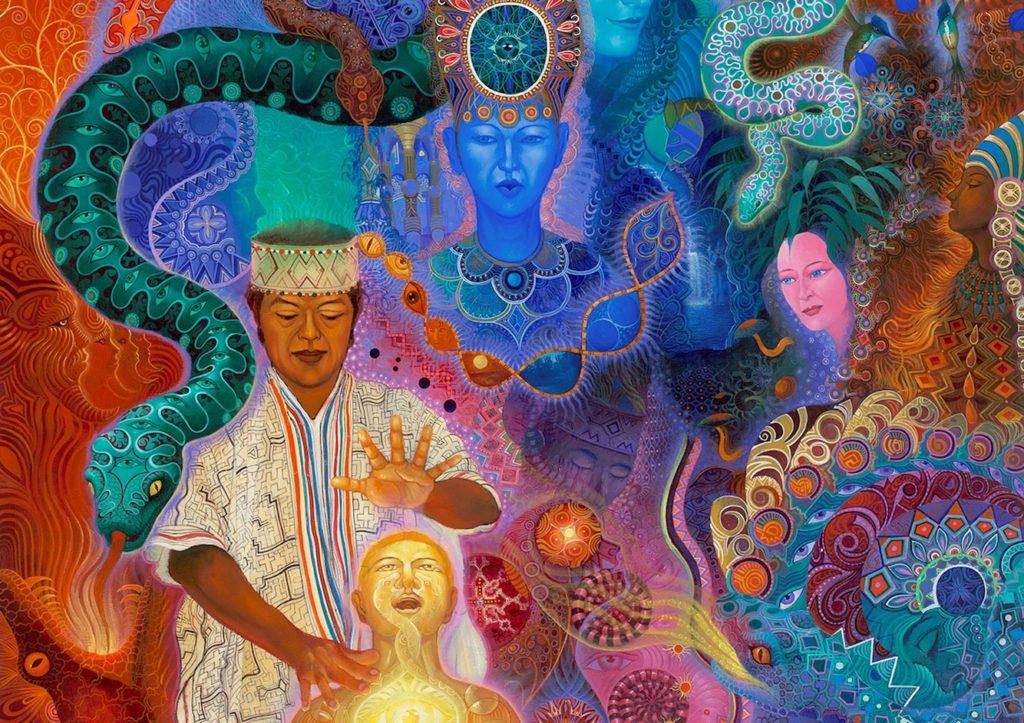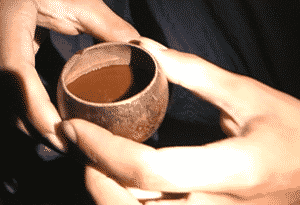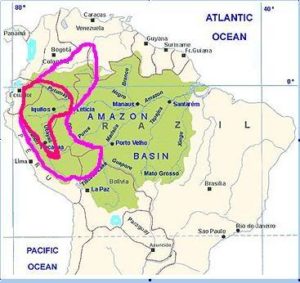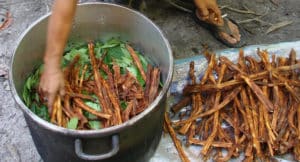The Beginner’s Guide to Ayahuasca Healing

Over the past decade, increasing numbers of Westerners have flocked to the Amazon for an experience of an ancient and potent hallucinogenic tea: ayahuasca. Used by the indigenous peoples of the region both a cure-all tonic as well as a sacrament for important spiritual, social and cultural events, ayahuasca has been popularized as a mind-blowing, life-altering experience that has the power to heal both physical and emotional ailments that Western medicine has failed to resolve.
Ayahuasca attracts Westerners to the Amazon for wide-ranging reasons. Some are in a last ditch attempt to heal serious illness or overcome addiction. Spiritual seekers are in pursuit of their next transcendental awakening. Business owners come looking for a creative entrepreneurial breakthrough. Others want to get over debilitating grief, emotional trauma, and anxiety.
An ayahuasca experience can be profoundly healing and positive, if approached in the right way. However, negative experiences abound, sometimes leaving ayahuasca ceremony participants in worse shape than before the ritual. These risks can be avoided with prior research and proper vetting of centers and facilitators.
To help you understand how this mysterious Amazonian brew works, here’s a beginner’s guide to ayahuasca, its effects, how the tea is for medicinal & spiritual purposes, as well as current scientific research on its therapeutic properties and potential applications.
MUST READ: The Uncensored Guide to Preparing for Ayahuasca Ceremony
What is Ayahuasca?
Ayahuasca is an ancient alchemical decoction originating in the jungles of the Amazon. It is made using a vine which contains a powerful naturally occurring psychedelic compound N,N-Dimethyltryptamine or simply DMT. The DMT is found within the vine, Banisteriopsis caapi (B. caapi) it is mixed with one of several other plants including Psychotria viridis (P. viridis). The admixture plants contain several alkaloids that function as monoamine oxidase inhibitors or MAOIs. The main alkaloids present in these are harmine, harmaline and tetrahydroharmine. These MAOIs work synergistically with the DMT to create an intense psychedelic experience.
The B. caapi vine is crushed along with the leaves of P. viridis (or other plants, depending on the tradition), then covered with water and gently boiled for several hours. Cups of the dark, bitter liquid are then drank during carefully overseen ceremonies, usually held at night.
The name Ayahuasca is derived from two Quechua words, a common language widely used throughout the Amazon Basin. The word “Aya” means “Soul or Dead” and the word “Huasca” means “Vine or Rope.” The literal translation for Aya-Huasca is “Vine of the Dead,” “Vine of Spirits” or “Vine of the Souls.” Ayahuasca is known by many names in South America – a few of the more common ones include Yagé, Caapi, La Purga, Natema, Mihi, La Medicina, Daime, Vegetal, Hoasca, Oasca or simply Aya.
This ancient drink is deeply rooted in the religious beliefs of many indigenous and mestizo groups. It is central to their healing ceremonies. Traditional ceremonial use of ayahuasca was persecuted by Spanish colonialists who were ignorant to its medicinal benefits.
Ayahuasca is said to heal many ailments, including depression and PTSD. It is also used to restore the immune system and is used to clear the body of parasites. Ayahuasca has incredible transformative effects; it can fortify not only the body but the mind and spirit as well.
Physiological Effects of Ayahuasca

The most common physiological effects of ayahuasca is the purge, or la purga. This is one of the most important parts of the ceremony. The purge is said to cleanse the person who is drinking. The purge is part of the learning process because the purge actually teaches you about your shadow and sickness.
Other physical effects include “Nausea, diarrhea, vibrating/shaking, both chills and sweats, body aches, involuntary movements, and other symptoms that resemble food poisoning or the flu.” During an ayahuasca journey you will experience difficulty walking or getting around. You may also experience sedation and some people even fall asleep. You can expect the physical effects before you have any visual hallucinations.
The onset of the physical effects typically begins within 20 – 60 minutes, peaking at around 1.5-2 hours. They will wear off after several hours, but you may feel differently within your body for days after the ceremony.
There is little physiological risk with ayahuasca, as long as you don’t have previous health conditions or mix it with contraindicated medications – more on this below.
Psychological Effects of Ayahuasca
The psychological effects of ayahuasca typically begin within 30-45 minutes after ingestion and will peak within the first and second hour. For the come down expect another 1-2 hours, and after effects or afterglow can last anywhere between 1-8 hours or in some rare instances even days after. The psychological effects of ayahuasca differ drastically from person to person.
Some of the psychological effects include profound feelings of connection with the universe and a renewed sense of love, empathy and compassion for everything living in it. Many people encounter a sense of peace, and an acceptance of others including plants, animals and the world at large. You may have a profound life changing spiritual experience. Often times people find relief from depression and experience deep emotional healing of past traumas as well.
Powerful visions that are typically reported include “Snakes, big cats, insectoid aliens and female goddesses,” and perhaps an incarnation of ayahuasca itself. You may experience “Meaningless visual noise, auditory hallucinations or sound distortions.” Time and space will make no sense at all and you may experience extreme time dilation. As noted on Erowid, there is an “Increased likelihood of embracing magical thinking and paranormal ideation.”
MUST READ: Should You Drink Ayahuasca Alone?
Some of the negative effects that one may or may not experience during the ceremony include “fear, paranoia, the feeling of losing one’s mind, feeling as though one is dying, unwanted overwhelming feelings, unwanted or unexpected life changing spiritual experiences, personal revelations or reliving of past traumas.”
You can find anecdotal reports all over the web about people that have taken ayahuasca in a ceremonial setting. They tell stories about experiencing revelations, spiritual awakenings or a sudden understanding of their purpose on the planet. There are many reports of people that change their careers or end toxic relationships after an ayahuasca ceremony. There is also scientific evidence that ayahuasca has an antidepressant effect (more below).
History of Ayahuasca & Geographic Location
The northwest region of the Amazon Basin where Colombia, Peru, Ecuador and Brazil come together is regarded as the origin of traditional ayahuasca use. Nearly all of the indigenous groups from these areas use ayahuasca ceremoniously.
Assigning an actual number to the Amazonian ethnic groups that use Ayahuasca is not a straightforward task, as it is often difficult to define whether two neighboring communities with similar customs and similar tongues constitute one ethnic group or two; Amazonian peoples themselves usually do not traditionally concern themselves with such definitions, as their traditional loyalties and identification have usually been to their own immediate village, and ethnic/tribal identity is a new concept that is developing in modern times as Amazonian peoples organize for their rights.
 Mestizo traditional usage has centers in Iquitos and Pucallpa, Peru. Outside of these areas, a large majority of indigenous people also use ayahuasca. The traditional usage of ayahuasca has been expanding outside of its birthplace and has now made its way around the world.
Mestizo traditional usage has centers in Iquitos and Pucallpa, Peru. Outside of these areas, a large majority of indigenous people also use ayahuasca. The traditional usage of ayahuasca has been expanding outside of its birthplace and has now made its way around the world.
Sadly, the true origins of ayahuasca use may never come to light. In “Ayahuasca: Sacred Vine of Spirits,” Ralph Metzner describes how we do not actually know for certain where the alchemical formula for brewing ayahuasca was first discovered. What we do know for sure is that it had already spread among a wide variety of indigenous tribes within the Amazon Basin by the time Western ethnographers stumbled upon it in the mid 19th century.
Current Use of Ayahuasca & Ayahuasca Culture
Currently ayahuasca is a booming business and that can spell trouble for an unsuspecting seeker or initiate. Unfortunately, the high cost of ayahuasca retreats has spawned several charlatans, frauds and sexual predators. Despite a few bad seeds in the world of ayahuasca, there are still plenty of good, honest, traditional or traditionally trained ayahuasqueros.
MUST READ: How to Choose an Ideal Ayahuasca Shaman, Facilitator or Retreat Center
There are many indigenous and mestizo groups that use ayahuasca as medicine. Many of the groups that are found in Peru are Vegetalistas. There are several others found in countries all over the Amazon Basin. Some are known as oracionistas and they focus on healing through prayers taken from books such as La Santa Cruz de Caravaca.
Two of the more popular groups are from Brazil. They are the Santo Daime and União do Vegetal (UDV) organizations. Both have won court battles in order to use ayahuasca in a legal ceremonial/religious setting in North America, and operate legally in many South American countries. These two groups combined Christianity with ayahuasca use, spreading ayahuasca further across the world.
All of these groups believe with unwavering conviction that most of their knowledge is derived from the ingestion of sacred plants. Which they aptly named plant teachers or doctores (doctors).
In the Western world ayahuasca is exploding in popularity. Many underground ceremonies are taking place every weekend all over the world. There are even legitimate options for you as well and if you feel called to ayahuasca, you should consider going to a place with years of experience. There are churches that serve ayahuasca as a sacrament such as the UDV and the Santo Daime Church. Alternatively, you can book a trip to the Amazon to experience an authentic ceremony in a traditional setting.
There is something interesting that’s happening in the Western world. There is a sudden surge of gurus and neo shamans or urban shamans taking people on ayahuasca retreats. A lot of these people seem to be the real deal but some of them are just doing it as a source of income and those are the dangerous ones. You really want to go with someone that has gone through traditional training or at the very least has humble intentions. You should know that your shaman has been to hell and back and would travel back in there to pull you out.
MUST READ: Is My Gringo Ayahuasca Facilitator Any Good?
Ayahuasca is different than most other psychedelic experiences — it is very powerful and long lasting. For this, a trained facilitator such as a licensed clinician or experienced shaman/ medicine person is your best option.
Some Westerners have actually gone to live in the Amazon to learn how to serve ayahuasca from indigenous and mestizo people after a profound ayahuasca experience of their own. Training to become an ayahuasquero is no easy feat. It requires years of training that includes a strict bland, plant based diet, sexual abstinence and a lot of ayahuasca which is taxing on the mind and body. These people come back to the states with traditional training and hold underground ceremonies for American seekers.
MUST READ: So You Want to Be An Ayahuasca Shaman?
Legality of Ayahuasca
There is a lot of confusion around the legality of ayahuasca, because the use and transport of ayahuasca is determined by individual countries’ laws around narcotics and controlled substances. Legality varies country by country. In some countries, ayahuasca, because it contains DMT, is a controlled substance that carries high criminal penalties. In other countries, decriminalization of personal drug use does not make a substance legal, and transportation is considered to be illegal.
Even in countries such as Peru, Ecuador, Colombia, Brazil, and Bolivia, where ayahuasca is considered a patrimony, legal usage for the indigenous does not automatically extend to foreigners in retreat centers, though authorities rarely prosecute. In Brazil, use of ayahuasca is legal in a religious context, however, therapeutic contexts (such as in the case of a psychotherapist administering ayahuasca to patients seeking addiction therapy) is not legal. Furthermore, in order to legally receive religious protection registration and documentation is required by the organization – not just anyone can claim their ayahuasca use is religious.
MUST READ: What is the Legal Status of Ayahuasca in Your Country?
Legal grey areas abound around the use of ayahuasca for religious and therapeutic purposes, and cases involving the transportation of ayahuasca tend to, by default, fall into the narcotics division of law enforcement.
While most countries, including the United States, signed the 1971 Convention on Psychotropic Substances, a United Nations Treaty, that includes the decree:
The Commentary on the Convention on Psychotropic Substances notes that while many plant-derived chemicals are controlled by the treaty, the plants themselves are not [emphasis added].
Yet, in most cases, countries maintain the right to have their national drug enforcement laws take priority over treaty agreements.
At the moment, in the United States, it is legal to buy and possess some of the unprocessed plant materials that make up ayahuasca – but it can become illegal when you extract the DMT from the plants. DMT is currently a Schedule 1 controlled substance. However, some US cities and the state of Oregon have decriminalized entheogenic plants, including ayahuasca. Read more about US decriminalization here.
In his book DMT: The Spirit Molecule, Dr. Rick Strassman M.D. talks about how he believes that the source of human DMT is from the “Mysterious pineal gland.”
MUST READ: Is DMT Made in Your Brain?
Recent legal cases in the Netherlands have shown how fragile the legality of ayahuasca is, with even religious exemptions being removed for groups like the UDV and Santo Daime. Learn more about the legal struggles surrounding ayahuasca here.
Healing with Ayahuasca

As discussed above, there are real dangers when looking for an ayahuasca facilitator or shaman. The effects of ayahuasca are very powerful and will leave you in a vulnerable state. Because of this, you must have complete trust for the group of people you will be working with.
Throughout the upper Amazon, there is a common belief that human beings, in particular shamans, have powerful urges to harm others. There are basically two kinds of shaman — they are either healers or sorcerers (Beyer, 2010). Healers are able to resist the urge to harm while the sorcerers either do not know how due to lack of experience, can not even if they try, or the darkest of them do not want to resist those urges. What separates healers from sorcerers is self control and discipline.
Self control of healers must be exercised in the form of keeping a strict plant based diet called “Dieta.” Healers must also resist the urge to use their magical darts (tsentsak) which are acquired at their initiation for frivolous or selfish purposes. It is the shaman who masters his desires and aims to heal with his tsentsak that gains the power to heal. Shamans who lack the self control to keep their desires in check become sorcerers. Healers learn to use their tsentsak to heal while sorcerers use their tsentsak to harm or kill.
Inexperienced practitioners are dangerous and could harm you just to see if they can. When they do, they begin down a dark path which is easy when compared to the path that healers must travel. The sorcerers can cause spirit possession or unknown illnesses due to their lack of experience.
Healers stay on a difficult path because they truly desire to heal with their powers. They receive gifts of healing and love magic from plant spirits. It is the healers that you must seek out if you are being called to ayahuasca.
Scientific Research
Ayahuasca definitely has some serious therapeutic value. There is lots of anecdotal evidence suggesting that it is indeed helping people with depression, PTSD, addiction and several other serious mental disorders. It also seems to help rid the body of parasites and it helps people resolve immune disorders.
The good news is that Western science is now backing up all of these anecdotal tales of miraculous healing. This research is complementing shamanic knowledge of the healing potential of ayahuasca.
One study of Brazilian adolescents who regularly used ayahuasca found that they were less likely to use alcohol than non-ayahuasca users (Doering-Silveira et al, 2005), and a preliminary observational study has shown that people with problematic substance use (dependence or addiction) found significant reductions in cravings after a single ayahuasca retreat (Thomas et al, 2013). Ayahuasca has been explored as a potential treatment for eating disorders, with many accounts surfacing of people who have recovered from severe eating disorders thanks to profound ayahuasca experiences (Lafrance et al, 2017).
MUST READ: Ayahuasca and Eating Disorders
Ayahuasca has also appeared in the scientific literature as a potential treatment for the most severe cases of depression. One preliminary report found that a single dose of ayahuasca had a significant healing benefit for patients in a psychiatric unit who were experiencing depression (Osório et al, 2015), and two years a later a randomized placebo-controlled trial of thirty-five patients proved that ayahuasca could effectively treat severe depression (Palhano-Fontes et al, 2017).
The effectiveness of ayahuasca in treating these conditions is due to the profound spiritual experience that it induces. Research has shown that the magnitude of the spiritual experience that accompanies a psychedelic trip is directly related to the healing benefits (Griffiths et al, 2016). Therefore, the set and setting of an ayahuasca experience, and the ability of the facilitators to induce and guide a spiritual journey, is key to its therapeutic properties
MUST READ: Can Ayahuasca Heal Depression
Ayahuasca Risks & Medical Contraindications
Ayahuasca is a serious plant medicine — it requires your utmost respect. There are dangers associated with ayahuasca. You must have the right set and setting for your journey.
To prepare you for ayahuasca, a special diet called dieta may be required. The dieta can help clean your body of toxins. You should seriously consider starting twenty days before, or at the very least, one week before your trip. The dieta is considered a good practice in order to prepare oneself physically, mentally and spiritually. This in turn will enhance your ability to receive the most benefits from the ayahuasca ceremony.
The real dangers of ayahuasca come from the participants themselves and not being honest about prescription or illegal drug use and that can become fatal. Although rare, ayahuasca deaths related to medical contraindications have occurred.
It is extremely important to mention SSRI medications to your shaman. Although there is as of yet no clear evidence that this is a risky contraindication, there is a theoretical risk of serotonin syndrome when combined with ayahuasca. Some shamans may prefer you to suspend SSRI medications, if they are non-essential.
You need to suspend MAOI medications before going on an ayahuasca journey. These drugs can cause serious illness including severe liver and kidney impairment, severe headaches, hypertension, cardiovascular disease and cerebrovascular disease, when combined with ayahuasca.
Brugmansia or Toé is a dangerous admixture that is used by some shamans. This plant looks like datura or angel’s trumpet and can cause permanent mental problems or be fatal if the dose is miscalculated.
5-MeO-DMT and Bufo alvarius are making their way into shamanic circles. Both bufotenine and 5-MeO-DMT may have deadly contraindications with the harmala alkaloids present in ayahuasca. Two known deaths have been recorded in the medical literature — harmaline and 5-MeO-DMT were found during their autopsies (Sklerov et al, 2005).
In conclusion, if you are seriously considering using ayahuasca for self healing, it is recommended that you do a lot of research before making any commitments. Ask your facilitator questions about the ingredients they use and get informed about what you are about to put into your body.
Ayahuasca can be a beautiful experience if done correctly. On the other hand, it can become a living nightmare with lasting or or even fatal consequences if you are not careful. If you are planning on buying the ingredients to do this on your own at home, please understand that ayahuasca is different than most other psychedelics. Ayahuasca is typically taken with an experienced shaman because it is very powerful.
For expert advice on choosing a responsible and experienced ayahuasca facilitator, and making the most of your plant medicine retreat, sign up to our Spiritual Evolution with Sacred Plant Medicines course.
References:
Beyer (2010). Self Control. Ayahuasca.com, retrieved from: http://www.ayahuasca.com/psyche/shamanism/self-control/
Doering-Silveira et al (2005). Report on psychoactive drug use among adolescents using ayahuasca within a religious context. Journal of Psychoactive Drugs 37(2), p141-144.
Griffiths et al (2016). Psilocybin produces substantial and sustained decreases in depression and anxiety in patients with life-threatening cancer: A randomized double-blind trial. J Psychopharmacol 30(12), p1181-1197.
Lafrance et al (2017). Nourishing the spirit: Exploratory research on ayahuasca experiences along the continuum of recovery from eating disorders. Journal of Psychoactive Drugs (DOI: 10.1080/02791072.2017.1361559)
Osório et al (2015). Antidepressant effects of a single dose of ayahuasca in patients with recurrent depression: A preliminary report. Revista Brasileira de Psiquiatria 37, p13-20.
Palhano-Fontes et al (2017). Rapid antidepressant effects of the psychedelic ayahuasca in treatment-resistant depression: A randomised placebo-controlled trial. Psychological Medicine 49(4), p665-673.
Sklerov J, Levine B, Moore KA, King T & Fowler D (2005). A fatal intoxication following the ingestion of 5-methoxy-N,N-Dimethyltryptamine in an ayahuasca preparation. Journal of Analytical Toxicology 29, p838-841.
Thomas et al (2013). Ayahuasca-assisted therapy for addiction: Results from a preliminary observational study in Canada. Current Drug Abuse Reviews 6, p30-42.
Image Credits:
Ayahuasqueros Healing by Anderson Debernardi
Balam is descended from a lineage of medicine women from Mexico and Guatemala from his mothers’ side. His great, great grandmother Mama Rosa and great-grandmother, known as Mama Linda were curanderas they lived and learned traditional healing modalities from the Maya of Chiapas Mexico. His mother and aunts still use some traditional recipes that have been verbally passed down their lineage for ages. His father is descended from the Kaqchikel Maya of Guatemala. Balam has survived eight near-death experiences including two that required time in the ICU.
At the age of sixteen, he had an initiation experience with psilocybin mushrooms and soon after began to grow his own. During the past twenty-four years, he has facilitated hundreds of mushroom journeys for friends and family. He has witnessed young men in danger of becoming gang members change and find purpose in life. He has witnessed mean, violent people become gentle, loving souls. He has helped many people beat depression, anxiety, addiction and most importantly suicidality.
Balam has successfully navigated through extreme trauma and abuse. He has beaten several addictions and severe PTSD. With experience, he has created a nontraditional, modern midnight mushroom ceremony. It is his firm belief “If you have a teen that has already attempted suicide you owe it to yourself and your child to at least try a mushroom journey. At this point what do you have to lose? Sometimes you have to do what you have to do to get a person out of the danger zone.”

Well written article! I learned some new information. Thanks!
What a great write up. Thanks
Superb and wise article! Thank you.
good info every 1 should read 10/10